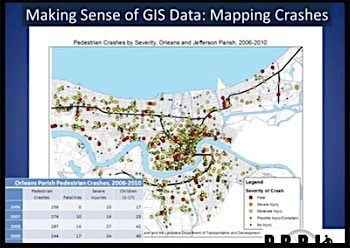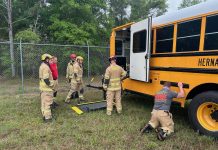 In the recent webinar, “Harnessing the Power of GIS for Safe Routes to School,” the Safe Routes to School (SRTS) National Partnership brought together GIS experts to discuss current uses, trends and stumbling blocks in school- and route-planning efforts.
In the recent webinar, “Harnessing the Power of GIS for Safe Routes to School,” the Safe Routes to School (SRTS) National Partnership brought together GIS experts to discuss current uses, trends and stumbling blocks in school- and route-planning efforts.
This webinar, along with a new SRTS report, was designed to help school administrators better understand GIS tools and maps that work to improve student safety.
Short for geographical information systems, GIS differs from GPS in that the former captures, analyzes, manages and combines all types of geographic information, focusing on the intended meaning of data rather than its syntax or structure. GPS is a satellite-based navigation system that complements GIS by collecting, storing and transferring data to GIS.
Robert Ping, technical assistance director for the SRTS National Partnership, noted that social media provides ample opportunity to engage the public and collect data for advocacy efforts to ensure the safety of students when they are traveling to and from school, whether by foot, bicycle or school bus.
“People can quickly and easily input information that we can then put on a GIS map,” Ping said. “GIS can help us increase funding, painting that picture for a decision-maker to show the needs we have, whether it is a lack of infrastructure or another issue. We have great stories from folks who have been advocating and using GIS for change.”
He pointed webinar participants to the report, “A Framework for GIS and Safe Routes to School: Improving Data Collection, Access and Usage,” which reports findings and recommendations from 15 GIS experts who participated in an April SRTS forum in Austin, Texas.
Topics included obtaining the data necessary for planning and implementation of SRTS walking and bicycling programs; creating standards for data collection, dissemination and storage; and ensuring these data are accessible to all people. Ping said the most common data-gathering methods include walkabouts, parent surveys and student tallies.
What are they looking for during walkabouts? He offered the following “Top 10” list of data: standard level of comfort, the presence of sidewalks, intersections, bicycle facilities, school location and catchment areas, traffic speed, collision data (see screen shot, above), health indicators, existing patterns and crime data.
“School locations and catchment areas are a critical piece for SRTS,” Ping added.
The Power of Information
Billy Fields, an assistant professor of political science at Texas State University and Louisiana’s SRTS representative, said the power of GIS is taking the information you collect in the field and turning it into data that you can present to policy makers. For example, when his group began creating the Austin, Texas Bicycle Map, the idea was to map the “high comfort” streets and to use color-coding to show which routes were safer than others for cyclists. The group had photos of high-comfort examples but at certain locations, researchers found bike lanes that ended abruptly amid heavy traffic.
“With GIS, we are marrying qualitative data, how people feel, with quantitative data — the type that planners and engineers respect,” Fields explained.
In terms of mapping safe routes for school bus transportation, he said that obtaining data on student housing often proves challenging for SRTS officials and recalled one project in New Orleans where they hit a wall.
“The group I was working with at the time was trying to figure out what the best bus routes were, and we couldn’t get the student data to figure out how to create good routes,” Fields recalled.
Ping noted that school districts are very proprietary about this information, so an individual or organization must become a “trusted partner” before expecting to access student data.
“If you’re having problems getting data, it could be a matter of talking with someone who is trusted by the school district who can promise they will keep that information private, because that is the primary concern,” shared Ping. “We can put dots on map, and from the SRTS perspective, that’s all we need.”
Erin Barbaro of the Center for Applied Research and Environmental Systems (CARES), discussed how layers of data (i.e., the environment, education, food, poverty rates, income levels, transportation and race/ethnicity) can be combined on a map to portray a community that might benefit from an SRTS grant for preschool students enrolled in Head Start programs, for instance.
In addition, she explained, GIS maps can assist in producing a Community Health Needs Assessment to gather data on students who receive free- and reduced-price lunch or students with special needs who have IEPs.
“This type of data is useful when speaking with policy makers and when trying to obtain grants,” Barbaro said. “It’s all about bringing a community together to share stories and strategies and to use the latest technology, including GIS mapping technology, to make change.”
















